The cultivation of Pyracantha and the method of making bonsai
Hippophae rhamnoides alias torch fruit, life-saving grain, Chiyangzi, Doujinang, water rubbing seed, Rosaceae, Firethorn genus, plant height of 1 to 3 meters, leaves Obovate, bright green, compound corymbose inflorescences, white flowers. The fruit is round, the ripe fruit is bright red, it does not wither after frost, and the red fruit hangs branches until the following spring.
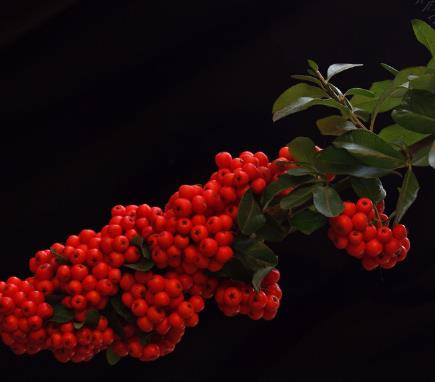
Firethorn is a newly developed bonsai tree species in recent years. Firethorn bonsai has three advantages: one is that the leaves and twigs are dense, which are suitable for potted plants, and the leaves are green all the year round and can be enjoyed all the year round; the second is that the branches are easily trimmed and shaped like a silver hook, and once shaped, it is difficult to change; and the third is that the hanging period is as long as October, in which red fruit branches can last as long as half a year, which is unique in ornamental bonsai.
Culture method of Pyracantha
1. Soil: Hippophae rhamnoides is not strict on soil, but in order to grow and develop well, we should choose deep soil layer; loose soil, rich in organic matter, fertile, good drainage, pH5. Five to seven. 3. Planting in slightly acidic soil is better.
2. Watering: Hippophae rhamnoides is resistant to drought, but the soil is dry in spring. It can be fertilized once before flowering and should be fully irrigated. Keeping the soil dry during flowering is beneficial to fruit setting, so don't water too much. If the florescence is in the rainy season, we should also pay attention to digging ditches and drainage to avoid falling flowers due to too much water. After the fruit is ripe and harvested, sufficient overwintering water should be filled before entering winter dormancy.
3, sunshine: Hippophae rhamnoides likes sufficient light, give sufficient light, can be more results, greatly increase the ornamental effect.
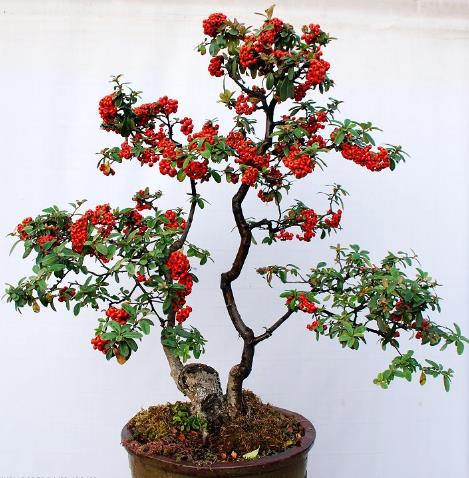
Maintenance of Pyracantha
Hippophae rhamnoides likes to be wet and fat, and likes a climate with sufficient light, good ventilation and warm and humid climate. Pyracantha is resistant to barren, and the temperature can be as low as 0 ℃-5 ℃ or less. Hippophae rhamnoides has developed root system, fast branching, rapid growth, resistance to pruning and flat binding.
The best soil for firethorn bonsai is the fatter garden soil or the surface soil in the mountain forest, and the mature base fertilizer, fine sand and cultivated soil can also be used.
The firethorn had better turn the basin once a year. Turn the basin to choose late autumn or early spring, that is, after stopping the growth of new shoots or before they begin to grow. For the fire thorn without hanging fruit, the pot can be changed all the year round. No matter when you change the soil, you should stay in the soil, cut off the long roots, do not nest the roots, and install the basin quickly so as not to affect the growth.
Firethorn bonsai is particularly afraid of drying and is vulnerable to diseases and insect pests. The disease mainly comes from external invasion or basin soil, including fungal infection, black rot and powdery mildew, especially powdery mildew.
The main control methods are carbendazim, topiramate and other fungicides, mainly spraying branches and leaves and irrigating roots. Usually placed in a ventilated and clean environment, sufficient light, exuberant growth, can reduce the incidence.
Aphids are the most common pests of Firethorn. The method of prevention and control is to spray trichlorfon and emulsified dimethoate in time. Generally spray in the afternoon, at least every three days, more than three times can be cured, but also can be found along with the spray.
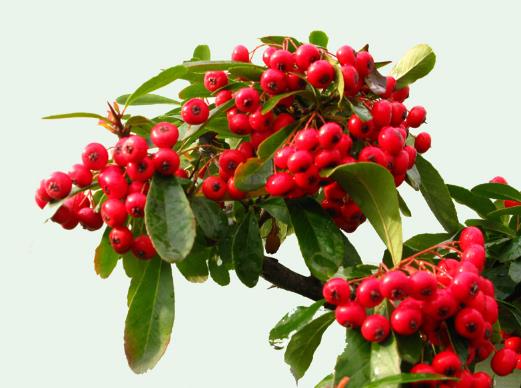
The function of Pyracantha
1. Watch. Hippophae rhamnoides is evergreen all the year round, the branches and leaves are soft and small, the leaves are waxy, white flowers bloom in spring, then hang green fruit, and the fruit becomes fiery red in late autumn. it is a very ideal flower bonsai with high ornamental value.
2. Works of art. Firethorn wood is hard and resilient. For more than ten years, firethorn is a first-class wood material, its roots can naturally produce abnormal and strange shapes, and 3-5-year-old firethorn roots can be used as root carving works of art.
3. Food. Hippophae rhamnoides fruit is rich in organic acids, proteins, amino acids, vitamins and a variety of mineral elements, which can be eaten fresh or processed into various beverages.
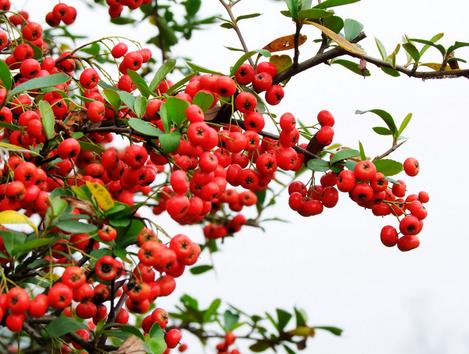
The method of making bonsai of Firethorn
First, cut in time: September is the best. Some people also think that it will be inserted in the spring and in the mildew and rainy season. According to our observation, in July and August every year, Hippophae rhamnoides differentiates into flower buds in the following year, and most of them complete the process of flower bud differentiation in September. In addition, the weather in September is getting cooler, and the ground temperature is still high, so the cuttings are not in danger of rot, but are suitable for the habit of Hippophae rhamnoides, and the survival rate can reach 100%.
2. Cutting process: 1. Cuttings: the sturdy branches of the current year are selected and cut into sections with a length of 10 Mel 15 cm. Two pairs of leaves are left in the upper part, and the lower leaves can be removed.
2. Matrix: River sand or loose permeable culture soil. River sand can be washed and disinfected with boiled water, cultured soil can be disinfected with formalin 50 times solution, or disinfected by sunlight exposure.
3. Cuttings: there are two methods: they can be first inserted into the river sand, keep moist every day, slightly shaded, and can take root after about 1 month. After rooting, they can be transplanted into a nutrition bowl containing culture soil and placed in a cold room to survive the winter; they can also be directly inserted into the culture soil, one bowl and one seedling, under the condition of 20 ℃ and 25 min, rooting for 30 days.
Third, modeling: after the oysters have survived, the box will be planted in March of the following year, and more humus soil and organic fertilizer can be added to the culture soil to make it germinate and grow luxuriantly as soon as possible. After flowering in May, you can change 4-inch pots for maintenance, and provide sufficient water and fertilizer to make the branches fully lengthened and thickened. It can be modeled at the end of August and the beginning of September.
Hippophae rhamnoides cuttings generally grow branches with a bud at the top, with a length of up to 1 meter in the current year, which should be protected rather than repaired.
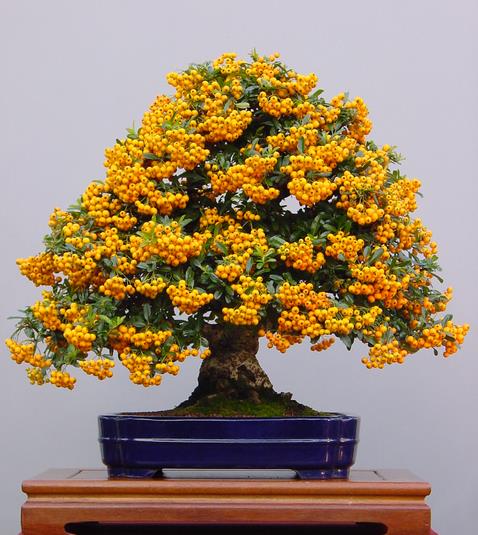
Propagation methods of Pyracantha
The ripening period of Pyracantha fruit is from September to December, and the seedling fruit is suitable to be harvested from January to February. After harvest, remove leaves, branches, stalks and other sundries, put it in a cool place and spread it for about 10-15 days, and turn it once a day.
Hippophae rhamnoides fruit is pear fruit, which contains a lot of pulp. First use a plastic basin or bucket, put an appropriate amount of warm water for 40 ℃, then soak the fruit in a container for 2 hours to make the peel soft, squeeze with hands, squeeze the seeds out of the pulp, then rinse with clean water for 4 to 5 times, remove sundries such as peel, pulp and shrivelled seeds, and obtain black seeds with high purity, ripe and full. The seeds and fine sand are mixed at 1:3. The fine sand should be sifted through a sieve of 200 meshes. The humidity is enough to hold the seeds into a ball, and it is appropriate to let go. Put the seeds in the lower layer of the indoor corner with 3cm thick fine sand, and the upper layer is covered with 5cm thick fine sand for storage, and often check the humidity to prevent freezing damage.
The reason for the failure of Hippophae rhamnoides
1. Improper breeding. During the period of flower bud differentiation, Hippophae rhamnoides is out of control of water, lack of light and unsuitable environment, so that its flower bud can not differentiate normally, which will make it difficult to blossom and hang fruit in the second year.
2. Improper fertilization. When applying fertilizer, Firethorn is out of balance, such as too much nitrogen fertilizer and insufficient phosphorus fertilizer, so that it can not normally bud and blossom and bear fruit.
3. Mistakes in pruning. Firethorn blossoms mostly on the annual short branches, but the thick and strong branches produced in the same year generally do not blossom. If the short branches are cut by mistake, it may lead to no flowering branches and can not blossom and bear fruit normally.
When does Firethorn blossom?
When did Firethorn blossom? Thorns, also known as rescue grain, life-saving food, torch fruit, red yangzi, Rosaceae Firethorn is an evergreen shrub or small tree, up to 4m high, usually propagated by sowing, cutting and striping. The florescence is from March to May. The fruit period is from August to November.
Overwintering in a cold room; it can also be directly inserted into the culture soil, with one seedling per bowl, rooting in 30 days under the condition of 20ml / 25 ℃.
Third, modeling: after the oysters have survived, the box will be planted in March of the following year, and more humus soil and organic fertilizer can be added to the culture soil to make it germinate and grow luxuriantly as soon as possible. After flowering in May, you can change 4-inch pots for maintenance, and provide sufficient water and fertilizer to make the branches fully lengthened and thickened. It can be modeled at the end of August and the beginning of September.
Hippophae rhamnoides cuttings generally grow branches with a bud at the top, with a length of up to 1 meter in the current year, which should be protected rather than repaired.

Propagation methods of Pyracantha
The ripening period of Pyracantha fruit is from September to December, and the seedling fruit is suitable to be harvested from January to February. After harvest, remove leaves, branches, stalks and other sundries, put it in a cool place and spread it for about 10-15 days, and turn it once a day.
Hippophae rhamnoides fruit is pear fruit, which contains a lot of pulp. First use a plastic basin or bucket, put an appropriate amount of warm water for 40 ℃, then soak the fruit in a container for 2 hours to make the peel soft, squeeze with hands, squeeze the seeds out of the pulp, then rinse with clean water for 4 to 5 times, remove sundries such as peel, pulp and shrivelled seeds, and obtain black seeds with high purity, ripe and full. The seeds and fine sand should be mixed at 1:3. The fine sand should be sifted through a sieve of 200 meshes. The humidity should be held in a ball by hand, and it is appropriate to let go. Put the seeds in the lower layer of the indoor corner with 3cm thick fine sand, and the upper layer is covered with 5cm thick fine sand for storage, and often check the humidity to prevent frost injury.
The reason for the failure of Hippophae rhamnoides
1. Improper breeding. During the period of flower bud differentiation, Hippophae rhamnoides is out of control of water, lack of light and unsuitable environment, so that its flower bud can not differentiate normally, which will make it difficult to blossom and hang fruit in the second year.
2. Improper fertilization. When applying fertilizer, Firethorn is out of balance, such as too much nitrogen fertilizer and insufficient phosphorus fertilizer, so that it can not normally bud and blossom and bear fruit.
3. Mistakes in pruning. Firethorn blossoms mostly on the annual short branches, but the thick and strong branches produced in the same year generally do not blossom. If the short branches are cut by mistake, it may lead to no flowering branches and can not blossom and bear fruit normally.
When does Firethorn blossom
When did Firethorn blossom? Thorns, also known as rescue grain, life-saving food, torch fruit, red yangzi, Rosaceae Firethorn is an evergreen shrub or small tree, up to 4m high, usually propagated by sowing, cutting and striping. The florescence is from March to May. The fruit period is from August to November.
- Prev

Culture method of bamboo begonia how to raise bamboo begonia
Culture method of bamboo begonia how to raise bamboo begonia
- Next

What should be paid attention to in planting potted strawberries? a complete collection of daily nursing methods for potted strawberries
What should be paid attention to in planting potted strawberries? a complete collection of daily nursing methods for potted strawberries
Related
- Wuhan Hospital Iron Tree Blooming Result Was Instantly Frightened by the Gardener Master
- Which variety of camellia is the most fragrant and best? Which one do you like best?
- What is the small blue coat, the breeding methods and matters needing attention of the succulent plant
- Dormancy time and maintenance management of succulent plants during dormancy
- Minas succulent how to raise, Minas succulent plant pictures
- What are the varieties of winter succulent plants
- How to raise succulent plants in twelve rolls? let's take a look at some experience of breeding twelve rolls.
- Attention should be paid to water control for succulent plants during dormant period (winter and summer)
- Watering experience of twelve rolls of succulent plants
- Techniques for fertilizing succulent plants. An article will let you know how to fertilize succulent plants.

